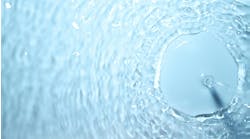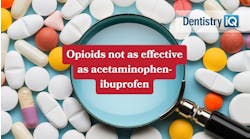By Steven Edwards, DDS
Since minor aphthous ulcers (canker sores not associated with systemic disease) afflict nearly 20 percent of the population,(1) dental professionals are often asked for information and advice about the condition. While the exact etiology of aphthous ulcers is still undetermined, present opinion leans to the view that the condition is immunologically driven and triggered by a number of factors including physical trauma, stress, hormonal state, family history, certain additives in dentifrices, and food hypersensitivity.(2)
There is no evidence that they are caused by a virus. Until recently, the only practical options for most patients were to suffer and wait for the sore to heal or seek symptom relief from a variety of OTC products or prescribed medications.
The most common OTC treatments aim to diminish the pain via three mechanisms:
• Application of a non-water soluble anesthetic such as benzocaine, (Anbesol [Wyeth Consumer Healthcare], Orajel [Del Pharmaceuticals] and many other brands), in a topical liquid or gel to the sore
• Application of a barrier via placement of a film-forming gel made with polymerizing materials like cyanoacrylate (Orabase Sooth-N-Seal [Colgate]) or cellulose suspended in an evaporating solvent (Zilactin [Blairex Laboratories, Inc.]) to prevent irritants such as acids and salts from touching the sore
• A combination of the two approaches (Zilactin-B [Blairex Laboratories, Inc.] and Kank-A [Blistex, Inc.])
While these treatment approaches can be useful, their effectiveness is limited because:
• The applied anesthetic is short-acting and can cause numbness in wider areas of the mouth
• They can be quite messy
• They have an unpleasant chemical/medicinal after-taste.
A new approach has now emerged that involves an adhesive oral patch (Cankermelts [Orahealth Corporation], Canker Cover [Quantum, Inc.], and Orajel Protective Discs [Del Pharmaceuticals]). These three patches effectively protect the ulcer while slowly dissolving and releasing active ingredients. Hence there is precise, time-released application and less mess.
Cankermelts is a thin disc made with "all natural" food gums consisting of gelatin, xanthan gum, and konjac gum. Once placed, the disc lasts two to six hours and releases licorice root extract, an ingredient that has anti-inflammatory properties and reduces pain. Canker Cover is made with synthetic carbomer, hydroxypropyl cellulose, and polyvinylpyrrolidone. The discs reportedly last eight to 12 hours and release menthol. Orajel Protective Discs, made with synthetic carbomer and zea mays (corn) starch, last up to two hours and release benzocaine, a synthetic topical anesthetic.
The use of non-synthetic ingredients (such as those found in Cankermelts) has important advantages because many individuals will not use products with synthetic chemicals like cyanoacrylate, polyvinylpyrrolidone, and carbomer, and prefer "natural" ingredients.
Both Cankermelts and Canker Cover provide pain relief without numbing, in contrast to Orajel Protective Discs, whose only active ingredient is benzocaine. Since benzocaine is a relatively large molecule (165 daltons) and not water soluble, it will not significantly migrate through the matrix structure of an oral patch made of gums. Therefore, upon application, the Orajel Disc releases a burst of benzocaine onto the sore, but then no more anesthetic is delivered to the needed area. Instead, as the disc dissolves, the remainder of the benzocaine is released from the non-adhered side of the disc, causing other areas of the tongue and mouth to become numb. These parts of the mouth may remain numb after the anesthetic effect has worn off.
Cankermelts and Canker Cover both use "natural" active ingredients and report research evidence for the efficacy of their products for pain relief and improvement in healing, although the published studies of Canker Cover were conducted with no controls.(3) Del Pharmaceuticals reports no research results for Orajel Discs. In clinical trials at the University of Washington funded by NIH, after three days of use, eight out of 10 people using Cankermelts about eight hours per day had no more base pain, twice the number of people who applied no treatment. After seven days of using about eight hours per day, canker sores treated with Cankermelts shrank to one-tenth their original size, while untreated canker sores grew larger.(4) In preliminary, uncontrolled studies with use of Cankermelts 16 hours per day, including during sleep, 98 percent of sores resolved to no pain within three days.(5)
Cankermelts and Canker Cover have different active ingredients. Cankermelts uses Glycyrrhiza (licorice root) extract (GX) which, as noted, is a proven anti-inflammatory and has a long and established history as a treatment for a variety of ulcers. The active ingredient in Canker Cover is menthol, a mild and very short acting anesthetic.
Canker Cover is highly hygroscopic and absorbs water until it is swollen to many times its original size. It is designed to stay in place when it adheres, and if removed before it is fully hydrated, it is difficult to pull off and can cause discomfort and possible tissue damage. Cankermelts and Orajel Discs can be easily removed.
Cankermelts will stick to orthodontic braces like wax, both protecting the sore from further irritation and releasing Glycyrrhiza (licorice root) extract (GX) directly onto the sore. Cankermelts will fully dissolve out of the braces in two to six hours and can be removed sooner by brushing.
The availability of these new adhesive oral patches is good news for canker sore sufferers, such as the teen experiencing ulcers as a result of orthodontic treatment or the adult with recurring ulcers. These three products have significant advantages over prior OTC treatments. In particular, Cankermelts and Canker Cover protective patches provide research-proven, non-numbing pain relief and improved healing time for people burdened with recurrent canker sores.
Although there may be valid reasons for recommending any of these canker sore solutions, I prefer products containing natural active ingredients that have long substantivity in the oral cavity, are easy, convenient, safe, effective, and have varied uses. Cankermelts fits my practice best because of its versatility in helping not only canker sores, but irritations from braces, partial dentures, toothbrush gum abrasions, sharp areas after extractions, inadvertent iatrogenic trauma, and many other non-canker irritations.
References
1 National Institutes of Health, National Institute of Dental and Craniofacial Research, NIH Publication No. 92-247, Revised July 1992
2 Scully C, Gorsky M, Lozada-Nur F, The diagnosis and management of recurrent aphthous stomatitis, JADA 2003;134:200-207.
3 Mizrahi B, Golenser J Wolnerman A, Domb A; Adhesive Tablet Effective for Treating Canker Sores in Humans, J Pharm Sci 93:2927-2935, 2004.
4 Martin M, Burgess J, and Haley J, Cankermelts patches reduce pain and speed resolution of aphthous ulcers, to be published in Journal of Dental Research, March 2007.
5 Haley J, Martin M, and Sherman J; Studies of licorice extract in an oral patch on minor aphthous ulcers, OOOOE 2005: 99: 429.




